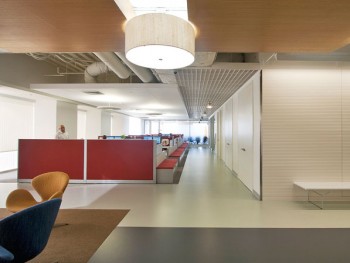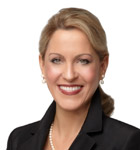Today’s workplaces are rarely as humdrum as the Dunder Mifflin office, home to the fictional paper company on The Office, and ad agencies have come a long way from the Sterling Cooper office featured in the 1960s-based TV series Mad Men. The truth is, not all companies opt for square offices, rows of cubicles, and formal boardrooms anymore. They’ve redefined what the modern office looks like, breaking the mold in what’s standard.
According to workplace-design experts, offices today are strategically designed to reflect a company’s unique corporate identity and brand, and to fulfill the company’s functional requirements, while also engaging employees and increasing productivity. Though overarching design principles determine an overall aesthetic, little details, or lack there of, can also make or break an office environment—and, in turn, make or break the job for its employees.
Straight from the pros at TPG Architecture, LLP, One Workplace, and OFM, Inc., Profile highlights key design elements to keep in mind when creating a dynamic, functional office space in today’s modern business world.
LAYOUT

The layout of an office is a huge factor in workplace design, and as of late, that design often varies between different rooms or areas of the same office. “Today’s office needs to inspire, motivate, and stimulate its inhabitants; encourage collaboration within and across departments; and enhance the collective abilities of its staff—and it must do all of this in a way that satisfies all roles within the organization,” explains Kelly Bacon, director of business development at TPG Architecture, a New York-based architecture and design firm specializing in workplace design. “A sales person undoubtedly works differently than a creative director, an HR manager works very differently than a programmer, and a financial consultant works very differently than an accountant, so the challenge becomes to accommodate all these ways of working while achieving a uniform aesthetic.”
Implementing unique designs for each department helps serve varying job requirements, but also “dresses” the different subcultures within a company. “Within our business itself, our sales department needs a closed-door environment because they’re doing relationship building, and I want them to feel comfortable and able to speak to customers in a way that’s not looked at by others like they’re not doing their work. So [office designs are] very much segmented within the businesses themselves,” says Blake Zalcberg, chief operating officer of OFM, Inc., one of the nation’s leading office- and school-furniture distributors and wholesalers with headquarters in Holly Springs, North Carolina, and operations in Phoenix and Taiwan.
In addition to segmentation, open layouts, and more informal meeting spaces, intended to foster interaction and collaboration, are a growing trend in office design across many industries. “Internet-based businesses like Facebook and Google are designing to create more collaborative environments so they can move furniture around,” Zalcberg says. “You don’t see as many cubicle environments. [Offices are] getting broken down to open up the doors between departments and people.”
According to One Workplace, a California-based, commercial-furniture dealership offering space-planning and interior-design services, there are several common themes across all of their Google projects, including the use of movable and reusable walls that allow rooms and meeting spaces to be made larger or smaller or opened up, depending on the unique business needs.
A similar open layout can also be seen in one of TPG’s recent projects, a 25,000-square-foot office in Irvine, California, completed in 2009 for Specific Media, a technology company with global offices that has rigorous workplace standards and many collaborative spaces. “The [result was] a floor plan with no assigned seats,” explains Pam Jacobs, LEED AP, director of marketing at TPG Architecture. “Other than private offices for the owners and the chief programmer, the plan is completely open, with what started out as a six-foot linear-benching desk system with low partitions and a return. … The new firm-wide workstation standard is a five-foot bench with no partition.”
There is also more of a need for smaller, more intimate meeting spaces intended for two people rather than large boardrooms with a capacity of 10–20 people. “There’s ‘I’ work and there’s ‘you-and-me’ work,” explains Mike Drez, executive director of sales at One Workplace. “We have found that 60 percent of people’s average day is working with two people and yet, currently, there is little space in most offices for two people.”
SPACE

Space planning is critical in workplace design because a company that does not optimize its space will most likely be less efficient. “Space is an underutilized tool to reach business objectives,” Drez says. “We follow a business-results model: No matter what your objectives are, you put people in the middle of the diagram. Around that you have processes and technology to reach those goals. What we are saying is all three come together and happen in physical space … [Many times] companies are not connecting those three with physical space to affect and improve the process, how people feel, and improve use of technology. It’s really critical. If you want to make people effective, you need to give them a space that supports what they’re trying to do. Like an ecosystem, if you change one component, you have to change another. Keep it fresh and relative.”
It’s also important for companies to keep in mind the amount of space they currently have as well as how much space they plan to have in the future. “Take for example a very large organization with tens of thousands or even millions of square feet, who over the years has suffered inefficiencies and redundancies, and who now faces multiple lease expirations,” Jacobs explains. “This presents us, the architect, with a very unique challenge. Not only can we assist the client in reducing its occupancy through efficient planning, but we can design the new workplace to be more conducive to today’s way of working, driven by technology and the desire for greater collaboration.”
As many companies consolidate, they often must also downsize workstations. “Another consistent trend is the reduction of personal space per employee, from the typical office worker up through chief executives,” Jacobs says. “All companies, in doing so, are giving space back in the form of meeting spaces both formal and informal, of different sizes and configurations. The challenge is in our understanding what each client needs and designing a solution that supports their specific needs.”
As personal space is minimized, storage becomes a critical need. TPG Architecture was challenged to address this issue in another recent project completed in 2007, for which the firm designed a 40,000-square-foot office for Mansueto Ventures, publisher of Inc. and Fast Company magazines. “In order to give back personal storage space lost in a low-partition environment, we designed a fun locker-room environment with shiny red units and custom graffiti on the walls of a wide building core corridor,” Jacobs says.
FURNITURE

Although sometimes overlooked, the choice and placement of furniture is a critical component of workplace design. This includes everything from chairs and couches to meeting tables and desks, which should all be consistent with the overall design theme. “Furniture has to complement and add to the aesthetic and texture of the space,” Drez says.
Furniture also plays a large role in employee comfort, as well as employee engagement. “Table designs and fabrics, shapes, and symmetry allow for a complete mood change depending on the environment in which you’re working,” Zalcberg explains. “We’ve all had the jobs we don’t enjoy … The environment gets lost. But we find that furniture that is functional and allows you to do your job better can really make a difference in your day.”
OFM takes pride in offering innovative, functional office furniture that is customizable. The company’s Vision Executive Chair, an executive standard task chair, comes in eight different removable machine-washable mesh covers in all colors. “It allows people to personalize their own chair,” Zalcberg explains. “A lot of time you go into an office and whatever chair is at your desk, that’s what you’re sitting in. If we allow purchasing owners to customize a product, it allows employees to be their own person in the workplace.”
Whether companies offer chairs that employees can personalize or put effort into selecting comfortable chairs and sturdy, functional desks and tables, it should be intentional and serve the company’s business goals and needs. “Furniture doesn’t have to be an afterthought, it can be a motivator to make your office look and feel good, and it improves morale,” Zalcberg says. “… It’s like walking into your best friend’s house, you’re going to be excited and want to hang out and look at all the new paint and furniture. It’s subconscious, but it makes you happy.”
COLOR
Like furniture, color can reflect a company’s brand and identity. For example, Google often uses bright, loud colors that are consistent with its logo and branding. In addition to branding, color can also inspire and impact how employees feel when they come to work. “When creating a creative, colorful environment, it’s kind of like painting a baby’s room, you want to use different colors to evoke different emotions,” Zalcberg explains.
Despite popular belief, it’s not always the advertising agencies that fill their offices with crazy colors while banks stick to drab, monotone shades and hues. “Historically, there is a generalization that financial or insurance firms are more conservative than advertising or media companies when it comes to use of color and materials in office design,” Jacobs says. “And while this remains true to a certain extent, we are seeing that all sectors of business are recognizing the importance of branding.”

To enhance the effects of color, some companies choose to mix and match, and even offer employees the opportunity to customize the color of their offices or pieces of furniture according to their style preferences. Because of this trend, many of OFM’s products, including its NET Series Chairs, are offered in a variety of colors. “The NET Series Chairs are a colorful, rustproof and fade-proof seating environment, and are offered in stand-alone, team seating, and with or without tabletop,” Zalcberg explains. “[They can be purchased in] oranges, reds, yellows or blues, and help evoke the emotions and colors associated with the outdoors.”
MATERIALS
One of the most prevalent trends in design materials today is the use of glass, [such as] glass front-office walls, partitions, and conference rooms, which lends itself to collaboration, visibility, and open communication. “[Glass] provides visual access between senior management and their reports, which serves to break down hierarchies, and encourage interaction,” explains Elisabeth Post-Marner, AIA, LEED AP, design director at TPG Architecture.
The materials of the furniture are also important, as they often dictate the comfort level of the user. OFM’s AirFlo Executive Chair has a mesh back with fabric and foam seat. “People associate mesh with a high-end look and feel, but are more comfortable with fabric seating and foam,” Zalcberg explains. “If you feel more comfortable at work, you are obviously going to do your work even better.”
TECHNOLOGY
Last, but not least, the use of technology is a critical factor in workplace design today. “Technology continues to revolutionize workplace design in that it’s enabling options once never dreamed possible,” Bacon explains. “Recent projections state that in less than 10 years, technology will have advanced drastically from what it is now. Our options, once limited, have opened up substantially.”
Evolving technology has led many companies to offer employees work-from-home or virtual- work opportunities. “Clients are beginning to test the waters of giving their staff the opportunity to work remotely, usually from home, part of a typical workweek,” Post-Marner explains. “This opportunity addresses employee needs, but makes the need for face-to-face interaction, when they are in the office, more important than ever. We find that there is no substitute for face-to-face collaboration and in environments that allow working remotely, it is more important than ever to leverage networking opportunities such as living rooms and coffee bars in the workplace.”

In addition to social interaction, there are other things people just can’t get at home. “Some people think offices are becoming irrelevant, because they have a laptop, cell phone, and think ‘I don’t even need to come in the office anymore,’” Drez says. “But people will always want to come back to the office … Telecommuters say, ‘I can work and do my laundry at same time. It’s great.’ But, it doesn’t work for people over a long period of time. They wake up one day and say, ‘I want to go somewhere to connect with people, connect with technology, and connect with culture.’”
THE TAKEAWAY
Although technology is changing the design of workplaces and allowing more and more employees to work remotely or while “on the go,” offices are still important for bringing people together, creating added efficiencies, and fostering culture.
When designing a new office, a company should always consider how the design—including the use of colors, materials, and furniture—can best represent its brand and identity, and what the design should achieve when it comes to how employees feel, and what boosts their productivity and efficiency. “The results model is critical,” Drez says. “If you’re trying to create a recreational space, your interests may not be as complex as making people effective. You can make a beautiful space but if it’s not effective, and it doesn’t make people smarter, better, more creative, then you’ve missed the mark. Corporations are based on making profit. The holy grail of making people effective is unique.”

